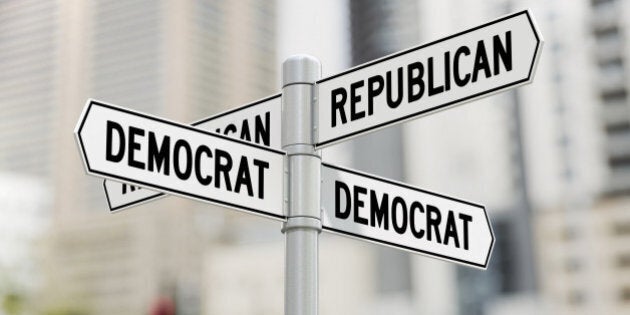
There's a great scene in The West Wing when Alan Alda's character, the Republican nominee, remarks, "If this were Europe, the Republican Party would be three parties." The Republican National Committee chairman retorts, "Thank goodness they don't have to sleep together. They just have to show up on the same day and vote Republican."
How relevant these words seem today in the age of Donald Trump.
The "big tent" factor of both American parties and the constraints of the "winner-take-all" presidency makes for some particularly strange bedfellows. But is the two-party system under attack this election cycle? It certainly seems so -- and it could well be to Secretary Hillary Clinton's advantage.
It is amusing, even confusing, for someone schooled in the Westminster political system to view how Americans go about labelling their politicians and dividing up their party loyalty.
In other Western democracies, there are essentially three, maybe four, major camps corresponding to three or more parties.
In particular, it's odd to see Senator Bernie Sanders -- who has sat in congress for decades as an independent -- challenging for the leadership of a party he only just recently joined. Stranger still is how he is simultaneously called a "socialist" and a "liberal," because in most democracies, these are two distinct labels for two distinct parties and ideologies. Socialism and liberalism are not synonymous, although occasionally they can be synergistic on some issues. (It seems in America, "liberal" is a catch-all term for a progressive, even a somewhat derogatory one at that.)
In the same way, why is a xenophobic, populist nativist like Donald Trump not leading a separate party like the United Kingdom Independence Party or Marie Le Pen's ultra-right-wing Le Front National in France? Such a scenario would have left the likes of Jeb Bush, Marco Rubio and John Kasich alone to run for a more respectable conservative party.
In other Western democracies, there are essentially three, maybe four, major camps corresponding to three or more parties. Let's call these four camps socialists and liberals ostensibly on the left and centre-left, and conservatives and reactionaries on the right and far right.
So, in Britain, you have the governing Conservative Party representing the right, but making overtures to moderate, modern voters and occasionally the odd sop (like Brexit) to its more reactionary members; the UK Independence Party appealing to anti-immigrant, populist sentiments; Labour is socialist, especially now under new leader Jeremy Corbyn, who is Sanders's British clone; and the Liberal-Democrats, who straddle the centre and sometimes veer to the left or right, depending on the issue.
In Canada, it's much the same. The New Democratic Party formerly professed to be democratic socialist and as embattled, centrist leader Thomas Mulcair attempts to hold on to the party leadership, it seems the erstwhile socialism is suddenly (or perhaps cynically) back in vogue (no doubt due to the influence of Sanders and Corbyn). Meanwhile, the centre-left Liberal Party has long been accused of "campaigning from the left but governing from the right," but nonetheless often acts as the middle ground between the NDP and Conservatives. And, of course, the Conservatives, after the merger of the Progressive Conservatives and the Reform Party, now have the right wing to themselves, and occasionally veer to the far right to motivate their base, although doing so arguably acts as a limit to their ability to stay in power, as in the 2015 federal election.
It's interesting how the division in, for instance, the UK and Canada between three or four major parties and philosophies corresponds to today's emerging divisions in the two American parties.
In particular, are we perhaps seeing the breaking up of the American two-party system as the Republican Party descends into civil war? The Republican Party is tearing itself to pieces, with about half the party trying to stop Trump, even as the likes of Chris Christie cave and accept the inevitable. It remains to be seen what will happen to the party, as the more moderate "establishment" finds itself divorced entirely from its nativist "Tea Party" base and their buffon, billionaire leader.
On the Democrat side, it's a strange confluence of circumstances that have allowed Secretary Hillary Clinton to simultaneously swing left and yet still appear to be the moderate candidate. Of course, she's been helped along by two diametrically opposed opponents in Sanders and the Republicans.
Clinton is certainly more comfortable in 2015 than she was in 2008 speaking unabashedly about progressive issues. As other commentators have noted, this is partly because the American electorate has seemingly moved left under President Barack Obama. Americans are now more likely than not to support equal marriage, to favour sensible gun control, to believe climate change is real and to favour drug policy that treats addicts rather than imprisoning people. (To the rest of the world, this newfound majority of common sense centrism seems like, in the words of the late, great comedian Robin Williams, "America is finally out of rehab".)
Meanwhile, with race-baiting, anti-immigrant sentiments dominating the Republican debates -- as a billionaire blowhard advocates mass deportation -- Clinton's progressiveness on social and race issues looks moderate standing between bizarrely right-wing Republican xenophobes and a socialist senator -- or as Saturday Night Live put it: "clowns to the left of me, jokers to the right, here I am: stuck in the middle with you".
With a socialist as her foil, and radical Republicans as her rivals, Clinton has managed to put herself squarely in the middle. Arguably, she's what Canadians in particular would recognise as the "liberal candidate" running against a socialist and conservative reactionary. In Canada, being a liberal--existing as the centre-left alternative between socialists and conservatives--has been an electoral sweet spot over the past century. Could the same hold true in America in November?
In short, Clinton has put herself right in the middle, exactly where the majority of the voters are said to be. And that's not too shabby a place to be, even if the rest of the world might still find the American two-party system strange.
Follow HuffPost Canada Blogs on Facebook
ALSO ON HUFFPOST:
Sign up for Peacock to stream NBCU shows.
to stream NBCU shows.
